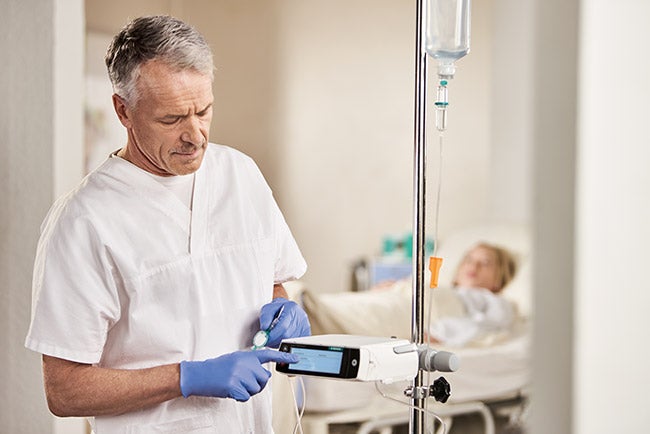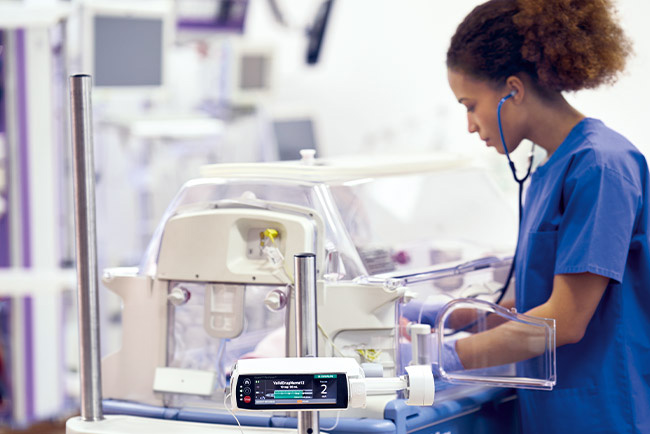You have successfully logged out.
Not registered yet?
Dosage Error in Paediatrics
Focus: Underdosing - Underestimated and Underappreciated
Avoiding medication errors is, of course, important in the entire field of medicine. In neonates, infants, and children, however, it is absolutely crucial as their physiological reserve is so much smaller than in adults. An improper dose that might pass unnoticed or results in more side effects in an adult can quickly become life-threatening in our youngest patients – and that includes underdosing, the often neglected stepchild of dosage errors.

Medical Professional
This information is meant for medical professionals only. Please confirm that you are a medical professional before accessing the information.
Confirm Yes, I am a health care professional. Cancel No, I am not a health care professional.One factor that plays a major role in underdosing is what literature refers to as “dead volume” or “residual volume”. These terms mean the same thing, namely, the (variable) volume of a prescribed drug that remains in the infusion system after the infusion has ended. Without taking measures to ensure that this volume is infused as well, the patient will not receive their full prescribed medication dose – with potentially adverse consequences such as inefficacy or resistance. Evidence has shown that the best way to avoid this from happening is to choose extension lines with a small diameter and the smallest syringe size possible, and to use infusion sets that can be flushed at the end of the infusion.21
Be it overdosing or underdosing, one thing remains the same: In paediatrics, there simply is no room for error. As error quickly become life-threatening in our youngest patients – and that includes underdosing, the often neglected dosage errors.
What are Dosage Errors?
A dosage error is the most frequent type of medication error in children.1, 2
A medication error can occur during the prescription, dispensing, or administration of a drug. By definition, it is considered an error regardless of whether or not it leads to adverse consequences.3, 4
Paediatrics is seen as an area particularly prone to medication errors: Children, toddlers and babies famously come in all shapes and sizes and are, therefore, dosed on an individual basis using factors such as age, weight, and surface area, which requires repeated manipulations and dilutions. In neonates especially, significant weight changes over time necessitate frequent re-calculations.5 In addition an appropriate dosage forms may not always be available.6
Did you know?
- Children are more at risk of medication errors than adults.7
- 20% of children under 4 years and 13% of children between 4 and 12 years of age experience dosing errors.6
- Underdosing is just as frequent as overdosing (approximately 11%).6
- Antiepileptics are the most frequently underdosed medication.6
One of the most frequent causes of underdosing is the incomplete delivery of the container content:
In 50 mL infusions, up to 32.2% of the active compound remains in the IV line.8, 9
50 mL IV antibiotics may be underdosed by up to 50%.10
Why are Dosage and Medication Errors a Risk in Paediatrics?
In paediatrics and neonatology, most errors occur during dispensing and administration; dosing errors, i.e., overdosing or underdosing, are the most frequently reported error type.1, 2
As mentioned in the introduction, underdosing may be due to dead volume.11 The dead volume may vary greatly depending on the type of infusion system used, the length and diameters of the infusion tubing and the application of distributors (e.g., Y-connectors). This can cause significant delays in drug administration, especially in small dosages and when using slow, concentrated infusions.11 Experts have warned that the significance of dead volumes in infusion bottles and sets is not yet widely appreciated.12
How much of the drug is lost depends on various factors, including:
- Medication volume: Losing 20mL of 100 mL is of greater significance than losing 20% of 500 mL.
- Guidelines on infusions: These do not always include adequate information on dead space, flushing, or drug incompatibilities.
- Infusion system: The biggest factors are inner diameter and length of the system: The bigger and longer a system is, the more drug can be lost. By contrast, the type of system, i.e., gravity vs. pump systems, does not affect the loss of drug.
- Fine-dosing medical devices with minimum residual volumes allow for maximum effect of the drug.
- Concentration and dosage: The higher the concentration of a drug, the more active substance is lost by residual volumes within the infusion system.
In addition, there is the issue of drug delivery: Slow-flowing, small infusion lines, such as in neonatal care, can considerably delay the active compound reaching the patient.13 In one experimental study, it took one and a half minutes for the medication to reach the simulated infant through a catheter alone; with extension tubing, it took seven minutes.11
Health consequences in paediatrics and neonatology
The health consequences of underdosing not only depend on the amount of the active compound lost to the patient but also on the substance itself: In drugs with a broad therapeutic index, even the loss of around 10% of the active substance can be without consequence. But in drugs with a narrow therapeutic window, underdosing may well lead to serious adverse consequences, including insufficient treatment, therapy failure, disease progression, and the development of resistance to antibiotics and cytostatic agents.12

Dead volumes in IV systems may also have grave consequences if the following infusion has a higher flow rate, as this would result in the residue being administered as a bolus. If the following infusion contains a drug incompatible with the previous infusion, precipitation may occur.14
Financial consequences
- A 2018 analysis estimated that 66 million potentially clinically significant medication errors occur in England annually, with an associated cost of £98 million. Studies involving medication in children contributed to this estimated cost; however, it was not possible to extrapolate what proportion of this figure accounted for paediatric care specifically.15
- In a study of medical liability suits filed from January 1985 through December 2001, the Physician Insurers Association of America found medication error to be the fifth most common misadventure for paediatricians. More than 30% of these cases resulted in a paid claim, with total indemnity at US$14.7 million.16
- A US Institute of Medicine report estimated that preventable medical errors result in total costs of between US$17 billion and US$29 billion per year in US hospitals (including the expense of additional care caused by the errors, lost income, household productivity, and disability).17
- The mean cost per medication error ranges from €2.58 to €111,727.08.18
- In one hospital with 337 beds, medication errors extended total hospital stay by an additional 303 days, with total costs of nearly €76,000 (drugs, medical material, radiographs, scans). The presence of medication errors doubled the cost per patient.19
Studies specifically analysing the financial consequences of underdosing are, to our best knowledge, still lacking. However, it stands to reason that the clinical sequelae mentioned above – insufficient treatment or treatment failure, development of resistance – will also increase costs by negatively impacting a patient’s need for additional or longer therapy and extending their length of hospital stay.
How to Reduce the Risk of Dosage Errors in Paediatrics and Neonatology?
Dos & Don´ts
- In general, be aware of the issue of dead volume and dead spaces in tubing, side ports, and connections.
- Choose extension lines that are made of stiff material such as PE and with a small inner diameter.
- Use the smallest syringe size possible.
- Select appropriate devices and technology:
Infusion sets to minimize dead volume
Use a shorter secondary administration set
Use micro droppers to ensure precise application of tiny volumes
Include a sufficient flushing procedure with flushing sets
- Use the highest flow rate possible and more diluted medication when possible.
- Use the appropriate amount of flush (1 to 1.3 times the dead volume of the infusion system used). Note: Both the compatibility of the flush and the flow rate must be supervised carefully, since flushing too quickly can have serious consequences, particularly with medicinal products with a narrow therapeutic range such as catecholamines.14
- Use an inline burette to ensure the precise application of fluids.20
Be aware that higher infusion volumes should, in principle, only be used in patients with no restriction on fluid intakes. They are impractical in, e.g., critically ill or pediatric patients due to the risk of volume overload.14
Highlight Safety Products for Pediatric Patients
Risk Prevention in Pediatrics & Neonatology
[1] Miller, M. R., Robinson, K. A., Lubomski, L. H., Rinke, M. L., & Pronovost, P. J. (2007). Medication errors in paediatric care: a systematic review of epidemiology and an evaluation of evidence supporting reduction strategy recommendations. Quality and Safety in Health Care, 16(2), 116-126.
[2] Cowley, E., Parry, B., Williams, G., & Smith, R. (2001). The effect of a novel intravenous lipid emulsion on plasma lipid profiles and postprandial lipemia in healthy volunteers. Current Therapeutic Research, Clinical and Experimental, 62(8), 545-555.
[3] James, J. T. (2013). A new, evidence-based estimate of patient harms associated with hospital care. Journal of Patient Safety, 9(3), 122-128.James JT, J Patient Saf 2013;9:122-128.
[4] Valentin, A., Capuzzo, M., Guidet, B., Moreno, R., Dolanski, L., Bauer, P., & Metnitz, P. (2006). Patient safety in intensive care: results from the multinational Sentinel Events Evaluation (SEE) study. Intensive Care Medicine, 32(10), 1591-1598.
[5] Conroy, S., Sweis, D., Planner, C., Yeung, V., Collier, J., Haines, L., & Wong, I. C. (2007). Interventions to reduce dosing errors in children: a systematic review of the literature. Drug Safety, 30(12), 1111-1125.
[6] Neuspiel, D. R., Taylor, M. M., & Wong, I. C. (2013). Reducing the risk of harm from medication errors in children. Health Services Insights, 6, 47-59.
[7] Zakharov, S., Tomas, N., & Pelclova, D. (2012). Medication errors—an enduring problem for children and elderly patients. Upsala Journal of Medical Sciences, 117(4), 309-317.
[8] Plagge, H., Golmick, J., Bornand, D., & Deuster, S. (2010). Evaluation of the dead volume in intravenous short-term infusion. EJHP Science, 16(2), 31-37.
[9] Federal Institute of Drugs and Medicinal Devices 2015; The Forgotten Residue: Dead Volumes of Short-term Infusions, Pub. No. 2.
[10] Dixon, R. (2015, November 25). Are you under infusing IV antibiotic infusions? [Webinar]. Sign up to Safety. https://www.england.nhs.uk/signuptosafety/wp-content/uploads/sites/16/2015/11/su2s-infusing-iv-antibiotics-webinar.pdf. accessed 21.11.2023.
[11] Gregerson, B. G., Divakaran, V. G., & Caldera, A. E. (2018). Spontaneous coronary artery dissection with left ventricular thrombus. Proceedings (Baylor University Medical Center), 31(3), 334-336.
[12] Lilienthal, N. (2010). The forgotten residue - dead volumes in short infusions. Pharma Publishing and Media Europe, 16(2), 31-37.
[13] Lala, A. C., Manohar, N., Ray, S., Wahid, A., Dasgupta, R., & Nagpal, R. (2015). The impact of social media on the health of children and young people. Journal of Paediatrics and Child Health, 51(12), 1152-1157.
[14] Mitteilung. (2017). Mitteilung: Die neue Leitlinie zur Behandlung von Patienten mit akuter Herzinsuffizienz. Deutsches Ärzteblatt, 114(40), 1835-1836.
[15] Conn, R., Kearney, O., Tully, M. P., Shields, M. D., & Dornan, T. (2018). Prescribing errors in children: why they happen and how to prevent them. The Pharmaceutical Journal, 301(7917), 1-6.
[16] Physician Insurers Association of America. Medication Errors Symposium White Papers. Washington, DC: Physician Insurers Association of America; 2000.
[17] Kohn L et al, (2000) To Err Is Human: Building a Safer Health System. Washington, DC: Committee on Quality of Health Care in America, Institute of Medicine. National Academies Press, ISBN: 9780309068376.
[18] Walsh, E. K., Hansen, C. R., Sahm, L. J., Kearney, P. M., Doherty, E., & Bradley, C. P. (2017). Economic impact of medication error: a systematic review. Pharmacoepidemiology and Drug Safety, 26(5), 481-497.
[19] Pinilla, J., Murillo, C., Carrasco, G., & Humet, C. (2006). Case-control analysis of the financial cost of medication errors in hospitalized patients. The European Journal of Health Economics, 7(1), 66-71
[20] World Health Organization. (2013). Pocket book of hospital care for children: Guidelines for the management of common childhood illnesses (2nd ed.). Geneva: World Health Organization.
[21] Lovich, Mark A. and Peterfreund, Robert A.. "Drug Flow Through Clinical Infusion Systems: How Modeling of the Common-volume Helps Explain Clinical Events " Pharmaceutical Technology in Hospital Pharmacy, vol. 2, no. 2, 2017, pp. 49-61. https://doi.org/10.1515/pthp-2017-0004








